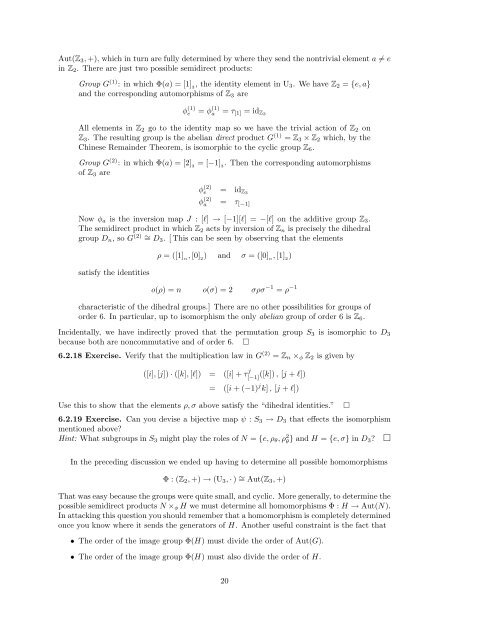Algebra I: Section 6. The structure of groups. 6.1 Direct products of ...
Algebra I: Section 6. The structure of groups. 6.1 Direct products of ...
Algebra I: Section 6. The structure of groups. 6.1 Direct products of ...
Create successful ePaper yourself
Turn your PDF publications into a flip-book with our unique Google optimized e-Paper software.
Aut(Z3, +), which in turn are fully determined by where they send the nontrivial element a �= e<br />
in Z2. <strong>The</strong>re are just two possible semidirect <strong>products</strong>:<br />
Group G (1) : in which Φ(a) = [1] 3 , the identity element in U3. We have Z2 = {e, a}<br />
and the corresponding automorphisms <strong>of</strong> Z3 are<br />
φ (1)<br />
e<br />
= φ(1)<br />
a = τ [1] = idZ3<br />
All elements in Z2 go to the identity map so we have the trivial action <strong>of</strong> Z2 on<br />
Z3. <strong>The</strong> resulting group is the abelian direct product G (1) = Z3 × Z2 which, by the<br />
Chinese Remainder <strong>The</strong>orem, is isomorphic to the cyclic group Z<strong>6.</strong><br />
Group G (2) : in which Φ(a) = [2] 3 = [−1] 3 . <strong>The</strong>n the corresponding automorphisms<br />
<strong>of</strong> Z3 are<br />
φ (2)<br />
e = idZ3<br />
φ (2)<br />
a = τ [−1]<br />
Now φa is the inversion map J : [ℓ] → [−1][ℓ] = −[ℓ] on the additive group Z3.<br />
<strong>The</strong> semidirect product in which Z2 acts by inversion <strong>of</strong> Zn is precisely the dihedral<br />
group Dn, so G (2) ∼ = D3. [ This can be seen by observing that the elements<br />
satisfy the identities<br />
ρ = ([1] n , [0] 2 ) and σ = ([0] n , [1] 2 )<br />
o(ρ) = n o(σ) = 2 σρσ −1 = ρ −1<br />
characteristic <strong>of</strong> the dihedral <strong>groups</strong>.] <strong>The</strong>re are no other possibilities for <strong>groups</strong> <strong>of</strong><br />
order <strong>6.</strong> In particular, up to isomorphism the only abelian group <strong>of</strong> order 6 is Z<strong>6.</strong><br />
Incidentally, we have indirectly proved that the permutation group S3 is isomorphic to D3<br />
because both are noncommutative and <strong>of</strong> order <strong>6.</strong> �<br />
<strong>6.</strong>2.18 Exercise. Verify that the multiplication law in G (2) = Zn ×φ Z2 is given by<br />
([i], [j]) · ([k], [ℓ]) = ([i] + τ j<br />
[−1] ([k]), [j + ℓ])<br />
= ([i + (−1) j k] , [j + ℓ])<br />
Use this to show that the elements ρ, σ above satisfy the “dihedral identities.” �<br />
<strong>6.</strong>2.19 Exercise. Can you devise a bijective map ψ : S3 → D3 that effects the isomorphism<br />
mentioned above?<br />
Hint: What sub<strong>groups</strong> in S3 might play the roles <strong>of</strong> N = {e, ρθ, ρ 2 θ } and H = {e, σ} in D3? �<br />
In the preceding discussion we ended up having to determine all possible homomorphisms<br />
Φ : (Z2, +) → (U3, · ) ∼ = Aut(Z3, +)<br />
That was easy because the <strong>groups</strong> were quite small, and cyclic. More generally, to determine the<br />
possible semidirect <strong>products</strong> N ×φ H we must determine all homomorphisms Φ : H → Aut(N).<br />
In attacking this question you should remember that a homomorphism is completely determined<br />
once you know where it sends the generators <strong>of</strong> H. Another useful constraint is the fact that<br />
• <strong>The</strong> order <strong>of</strong> the image group Φ(H) must divide the order <strong>of</strong> Aut(G).<br />
• <strong>The</strong> order <strong>of</strong> the image group Φ(H) must also divide the order <strong>of</strong> H.<br />
20

















